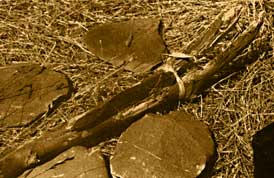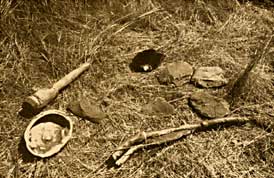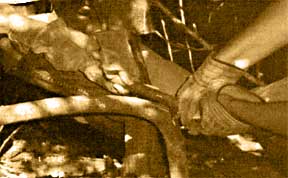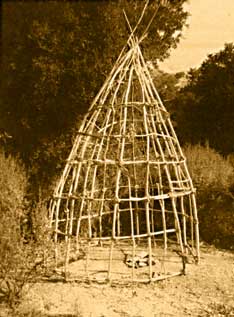
Most people are familiar with stone axes and celts for cutting
down trees. In central California neither of these tools are found
in the archeological record, and most of the houses built were
framed with relatively small diameter trees (1 - 3 inches). My
experience of trying to cut down springy willows with a stone
axe led me to believe there must be a better way.
After asking local archaeologists to no avail, I called Craig
Bates, Curator of the Indian Museum in Yosemite, who told me about
the historic use of a stone slab as a crosscut saw. Later I found
documentation describing a group of four Indian men cutting down
a tree. Two men used their carrying nets hooked together to catch
and bend down the tree, the other two used a stone slab as a saw
to cut the tree in about a minute. Working alone, I found it took
me three to five minutes to cut down a willow 1.5 - 2 inches thick,
bending it over with one hand and cutting with the other.
Over the past two summers I have undertaken the construction of
a thatched central California Indian-style house using all stone
age tools and materials. Using a straight 6 inch-long flake of
metabasalt I had been given by a knapper friend, I created a stone
saw. It was used to cut a one inch thick oak branch and split
it part way. I inserted the flake into the split, creating a large
"Hoko knife". (see photo)


Then, with a group of volunteers, I set out to cut down a dozen
2 inch diameter willows for house poles. Using the hafted saw,
we could cut down a tree in just over a minute with four people
as in the ethnographic account. Other members of the group created
some crude edged tools that we also tried. These took about three
minutes or so, because of the difficulty in holding onto them.
Some trees took longer simply because of their position, and the
difficulty of getting them properly bent over. The largest size
that would be practical to cut seems to be about 3 to 4 inches
in diameter, at which size an axe begins to work more efficiently.
The stone saw works only on green wood, and only when the tree
is bent over sharply. This allows the saw to cut without side
friction and jamming. It cuts about an eighth of an inch per motion.
If proper pressure is not applied to the base of the tree, a series
of splits will form in the end of the piece. Pushing down on the
end above the cut moves the splits down to the stump, or eliminates
them altogether. When the position of the tree permits, it can
be cut half way through and then bent back the other way for a
final cut. Where the second bend was not practical, I found I
could cut most of the way through and then simply stomp down above
the cut and peel it away from the stump, or pull up on the pole
and peel it away. Smaller poles for binding on the thatch took
about 30 seconds to cut. The saw's efficiency was quite gratifying
to all of us, as we got our poles cut and carried them back to
the building site in about two hours, less than the time it would
take me with a steel saw working alone (hauling would take longer).

This exercise was the first of many in which the importance of
the community became apparent. It would be very unlikely for a
lone person to be building a house, and would indeed be very hard.
The presence of a community provides a broader knowledge base
as well as work force when needed. The additional time needed
for the four person crew was made up for by the time saved in
carrying and cleaning the poles, and in constructing the frame.
As we got better at using the stone saws (and the bone saws for
cutting the tule thatch), it became apparent that the use of stone
tools within the context of a knowledgeable group was highly practical
and did not add significantly to the time involved in house construction.

This article was first published in The
Bulletin of Primitive Technology (Fall 2000, #20)
E-mail your comments to "Norm Kidder" at atlatl1@aol.com
We hope the information on the PrimitiveWays website is both instructional and enjoyable. Understand that no warranty or guarantee is included. We expect adults to act responsibly and children to be supervised by a responsible adult. If you use the information on this site to create your own projects or if you try techniques described on PrimitiveWays, behave in accordance with applicable laws, and think about the sustainability of natural resources. Using tools or techniques described on PrimitiveWays can be dangerous with exposure to heavy, sharp or pointed objects, fire, stone tools and hazards present in outdoor settings. Without proper care and caution, or if done incorrectly, there is a risk of property damage, personal injury or even death. So, be advised: Anyone using any information provided on the PrimitiveWays website assumes responsibility for using proper care and caution to protect property, the life, health and safety of himself or herself and all others. He or she expressly assumes all risk of harm or damage to all persons or property proximately caused by the use of this information.
© PrimitiveWays 2013